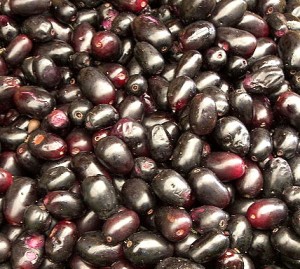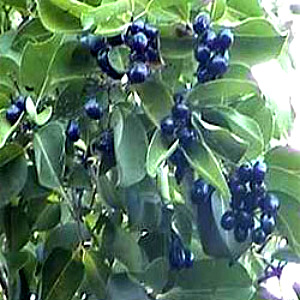 The Java Plum (Sizygium cumini) or Black Plum is a large, evergreen and exotic tree from the Myrtaceae family. It is popularly known as “Duhat” in the Philippines. Java Plum has been introduced to many different places where it has been utilized as a fruit producer, as an ornamental and also for its timber. A fairly fast growing species, it can reach heights of about 8 to 14 meters or more and can live more than 100 years. Java Plum trees start flowering from March to April and the fruits develop by May or June. Leaves are broad-tipped, opposite, shiny and leathery, ellipitic, 6 to 15 cm long. Flowers, small, pinkish, in clusters, petal arranged to form a cup. Fruit is oval, 1 to 2 cm long, dark purple to black, fleshy and one-seeded. It has a combination of sweet, mildly sour and astringent flavor and tends to color the tongue purple. It has a high source in vitamin A and vitamin C.
The Java Plum (Sizygium cumini) or Black Plum is a large, evergreen and exotic tree from the Myrtaceae family. It is popularly known as “Duhat” in the Philippines. Java Plum has been introduced to many different places where it has been utilized as a fruit producer, as an ornamental and also for its timber. A fairly fast growing species, it can reach heights of about 8 to 14 meters or more and can live more than 100 years. Java Plum trees start flowering from March to April and the fruits develop by May or June. Leaves are broad-tipped, opposite, shiny and leathery, ellipitic, 6 to 15 cm long. Flowers, small, pinkish, in clusters, petal arranged to form a cup. Fruit is oval, 1 to 2 cm long, dark purple to black, fleshy and one-seeded. It has a combination of sweet, mildly sour and astringent flavor and tends to color the tongue purple. It has a high source in vitamin A and vitamin C.
Java Plum or Duhat fruit can be eaten raw and can be made into tarts, sauces and jams. Good quality Java Plum juice is excellent for sherbet, syrup and “squash”, an Indian drink.
In the Philippines, Java Plum are an important source of wine, somewhat like Port, and the distilled liquors, brandy and “jambava” have also been made from the fermented fruit. It can also be made into Vinegar.
Java Plum seeds are known for the treatment of diabetes, as are the leaves and the juice from the fruit. The bark is astringent and in decoction is used as a mouthwash and as a gargle for ulcerations of the mouth.
How to grow Java Plum or Duhat
Climate
The Java Plum tree grows well from sea-level to 6,000 ft (1,800 m) but, above 2,000 ft (600 m) it does not fruit but can be grown for its timber. It develops most luxuriantly in regions of heavy rainfall, as much as 400 in (1,000 cm) annually. It prospers on river banks and has been known to withstand prolonged flooding. Yet it is tolerant of drought after it has made some growth. Dry weather is desirable during the flowering and fruiting periods. It is sensitive to frost when young but mature trees have been undamaged by brief below-freezing temperatures.
Soil
Despite its ability to thrive in low, wet areas, the tree does well on higher, well-drained land whether it be in loam, marl, sand or oolitic limestone.
Propagation
Java Plum seeds lose viability quickly. They are the most common means of dissemination, are sown during the rainy season in India, and germinate in approximately 2 weeks. Semi-hardwood cuttings, treated with growth-promoting hormones have given 20% success and have grown well. Budding onto seedlings of the same species has also been successful. Veneer-grafting of scions from the spring flush has yielded 31% survivors. The modified Forkert method of budding may be more feasible. When a small-fruited, seedless variety in the Philippines was budded onto a seeded stock, the scion produced large fruits, some with seeds and some without. Approach-grafting and inarching are also practiced in India. Air-layers treated with 500 ppm indolebutyric acid have rooted well in the spring (60% of them) but have died in containers in the summer.
Culture
Seedlings grow slowly the first year, rapidly thereafter, and may reach 12 ft. (3.65 m) in 2 years, and begin bearing in 8 to 10 years. Grafted trees bear in 4 to 7 years. No particular cultural attention seems to be required, apart from frost protection when young and control measures for insect infestations. In India, organic fertilizer is applied after harvest but withheld in advance of flowering and fruiting to assure a good crop. If a tree does not bear heavily, it may be girdled or root-pruned to slow down vegetative growth.
The tree is grown as shade for coffee in India. It is wind-resistant and sometimes is closely planted in rows as a windbreak. If topped regularly, such plantings form a dense, massive hedge. Trees are set 20 ft. (6 m) apart in a windbreak; 40 ft (12 m) apart along roadsides and avenues.

Fruiting Season
The fruit is in season in the Marquesas in April; in the Philippines, from mid-May to mid-June. In Hawaii, the crop ripens in late summer and fall. Flowering occurs in Java in July and August and the fruits ripen in September and October. In Ceylon, the tree blooms from May to August and the fruit is harvested in November and December. The main fruiting season in India and southern Florida (where the tree blooms principally in February and March) extends through late May, June and July. Small second crops from late blooms have been observed in October. Individual trees may habitually bear later than others.
Harvesting and Yield
In India, the fruits are harvested by hand as they ripen and this requires several pickings over the season. Indian horticulturists have reported a crop of 700 fruits from a 5-year-old tree. The production of a large tree may be overwhelming to the average homeowner.
Pests and Diseases
In Florida, some Java Plum trees are very susceptible to scale insects. The whitefly, Dialeurodes eugeniae, is common on jambolans throughout India. Of several insect enemies in South India, the most troublesome are leaf-eating caterpillars: Carea subtilis, Chrysocraspeda olearia, Phlegetonia delatrbc, Oenospila flavifuscata, Metanastria hyrtaca, and Euproctis fraterna. These pests may cause total defoliation. The leafminer, Acrocercops phaeospora, may be a major problem at times. Idiocerus atkinsoni sucks the sap of flowering shoots, buds and flower clusters, causing them to fall.
The fruits are attacked by fruit flies (Dacus diversus in India), and are avidly eaten by birds and four-footed animals (jackals and civets). In Australia, they are a favorite food of the large bat called “flying fox.”
Diseases recorded as found on the Java Plum by inspectors of the Florida Department of Agriculture are: black leaf spot (Asterinellapuiggarii); green scurf or algal leaf spot (Cephaleuros virescens); mushroom root rot (Clitocybe tabescens); anthracnose (Colletotrichum gloeosporioides); and leaf spot caused by Phyllosticta eugeniae.
Food Uses
Java Plum of good size and quality, having a sweet or sub-acid flavor and a minimum of astringency, are eaten raw and may be made into tarts, sauces and jam. Astringent fruits are improved in palatability by soaking them in salt water or pricking them, rubbing them with a little salt, and letting them stand for an hour. All but decidedly inferior fruits have been utilized for juice which is much like grape juice. When extracting juice from cooked java plums, it is recommended that it be allowed to drain out without squeezing the fruit and it will thus be less astringent. The white-fleshed java plum has adequate pectin and makes a very stiff jelly unless cooking is brief. The more common purple-fleshed yields richly colored jelly but is deficient in pectin and requires the addition of a commercial jelling agent or must be combined with pectin rich fruits such as unripe or sour guavas, or ketembillas.
In India, the latter is a bottled drink prepared by cooking the crushed fruits, pressing out the juice, combining it with sugar and water and adding citric acid and sodium benzoate as a preservative.
Sources: Wikipedia.org and www.billbritt.info; Photos: Wikipedia.org, exoticorchard.com